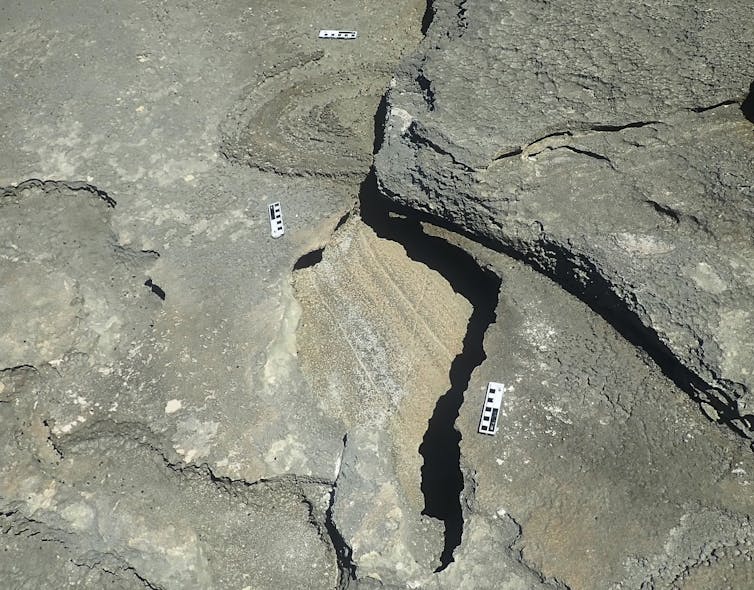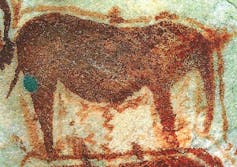Over the past 15 years, through our scientific study of tracks and traces, we have identified more than 350 fossil vertebrate tracksites from South Africa’s Cape south coast. Most are found in cemented sand dunes, called aeolianites, and all are from the Pleistocene Epoch, ranging in age from about 35,000 to 400,000 years.
During that time we have honed our identification skills and have become used to finding and interpreting tracksites – a field called ichnology. And yet, every once in a while, we encounter something we immediately realise is so novel that it has been found nowhere else on Earth.
Such a moment of unexpected discovery happened in 2019 along the coastline of the De Hoop Nature Reserve, about 200km east of Cape Town. Less than two metres away from a cluster of fossil elephant tracks was a round feature, 57cm in diameter, containing concentric ring features. Another layer was exposed about 7cm below this surface. It contained at least 14 parallel groove features. Where the grooves approached the rings, they made a slight curve towards them. The two findings, we hypothesised, were connected with each other and appeared to have a common origin.
Elephants are the largest, heaviest land animals. They leave large, deep, easily recognisable tracks. We’ve documented 35 fossilised elephant track sites in our study area, as well as the first evidence of fossilised elephant trunk-drag impressions.
Elephants, like another group of massive land creatures, dinosaurs, can be viewed as geological engineers that create minor earth-moving forces on the ground they walk(ed) on. This can be related also to a remarkable ability that elephants possess: communicating by generating seismic waves. These are a form of energy that can travel under the surface of the Earth.
The feature we found in 2019 seemed to reflect just such a phenomenon: an elephant triggering waves that rippled outwards. After additional investigation and a thorough search for alternative explanations, we could report in a recently published study that we believe we’ve found the world’s first trace fossil signature of seismic, underground communication between elephants.
Elephant seismicity
Since the 1980s, an ever-increasing body of literature has documented “elephant seismicity” and seismic communication through infrasound. The lower threshold of human hearing is 20Hz; below that, low frequency sounds are known as infrasound. Elephant “rumbles”, originating in the larynx and transmitted into the ground through the limbs, fall within the infrasonic range.
Infrasound at high amplitude (it would seem very loud to us if at a slightly higher frequency) can travel further than high frequency sounds, over distances as great as 6km. Elephants have an advantage here. Lighter creatures cannot generate low-frequency sound waves through vocalisation. It is thought that long-distance seismic communication can allow elephant groups to interact over substantial distances, and it has been shown that sandy terrain allows the communication to travel furthest.
Read more: Fossil tracks and trunk marks reveal signs of ancient elephants on South Africa's coast
Continuing the elephant-dinosaur analogy, we considered the multitude of publications on dinosaur tracks. We are aware of only a single example that exhibits possible concentric rings within a track, from Korea, and none that involve parallel grooves. This suggests something unique about elephants that generates concentric rings within tracks and leads to the associated groove features. Elephant rumbling provides a plausible explanation.

In our scenario at De Hoop Nature Reserve, we postulate that vibrations from rumbling travelled down the elephant limb and created the concentric ring features. They are reminiscent of some of the patterns that become evident when sprinkling sand onto a vibrating surface. The surface on which the concentric rings appear must have been just below the dune surface at the time. The parallel grooves would then represent a trace fossil signature of subsurface communication. We’re not yet sure how old the trace fossil is; we’ve sent samples for testing.
Rumblings in rock art
Elephant seismicity is a relatively new field of study for scientists. However, those who have lived close to elephants won’t be surprised at the idea of the animals communicating through vibration. Indeed, vibrations from elephant rumblings can sometimes be felt (rather than heard) by the astute observer. And it appears that this knowledge is not just recent.
The rock art experts on our team have identified and interpreted rock art that suggests the indigenous San people appreciated and celebrated this knowledge in southern Africa thousands of years ago. Elephants were of profound importance to the San and were prominently featured in their works of art. Several rock art sites appear to contain paintings of elephants in relation to sound or vibration.
For example, at the Monte Cristo site in the Cederberg the artist has painted 31 elephants, in several groups. They are in a realistic arrangement. Fine red lines surround each elephant; zigzag lines touch the abdomen, groin, throat, trunk, and specifically the feet. Many zigzag lines link the elephant to the ground. The finest lines are closest to the elephants, and every elephant is connected to this set of lines. These are in turn connected to broader lines surrounding the elephant group, which radiate out and away from the elephants as concentric rings.

This is interpreted as the San artist’s probable illustration of seismic communication between elephants. The feeling of shaking and vibration, which the San call thara n|om, is vital to the San healing dances, including the elephant song and elephant dance. Lines of energy, called n|om, are regarded as a vibrant life-giving force that animates all living beings and is the source of all inspired energy.
We believe that an understanding of elephant seismicity requires the integration of three bodies of knowledge: research on extant elephant populations, ancestral knowledge (often manifested in rock art) and the trace fossil record.
That elephant seismic communication might leave a trace fossil record has never been reported before, or even postulated. Our findings may have the potential to stimulate multi-disciplinary research into this field. This could include a dedicated search for sub-surface patterns in the sand in the vicinity of modern rumbling elephants.

